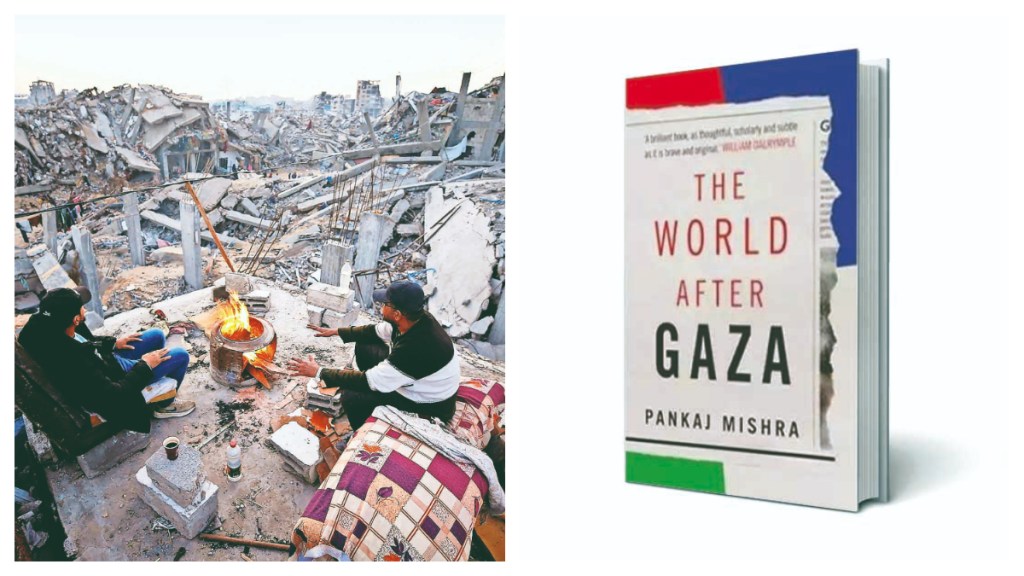How does one describe the world we live in after “the massacres and hostage -taking in Israel on October 7, 2023, by Hamas” and the brutal, disproportionate war of retribution and revenge that the Jewish state has waged on Palestine and its hapless citizens? This is the complex and deeply troubling question that acclaimed author Pankaj Mishra interrogates in his tenth book, The World After Gaza, with incandescent angst. The result is 280 pages of a rigorous inquiry into the genesis of this unparalleled Zionist violence.
Gaza has been ravaged and bombed to rubble and its residents killed, maimed for life or forced to flee. A tentative ceasefire was brokered in mid-January on the eve of the Biden-Trump transition, but it remains shaky even as Israeli hostages and Palestinian prisoners are being exchanged.
In a cynical and callous reduction of the unprecedented tragedy that has befallen Gaza, US President Donald Trump has floated an outrageous and feckless proposal for 2.3 million Palestinians to be re-located in third countries and Gaza rebuilt under American stewardship so that it becomes ‘beautiful’!
Empathy for Palestine has evaporated. There is no light at the end of this blood splattered Israel-Palestine tunnel and a weary world is either numbed with grief or cynically indifferent to what has unfolded in the aftermath of the Hamas attack.
Recalling the philosopher Karl Jaspers who spoke (in 1945) of ‘metaphysical guilt’ — the guilt of failing to do what one can to prevent wrong-doing and injustice — Mishra’s book is a personal catharsis to atone for this guilt. He describes the motivation to write this Gaza book as “ I write out of that guilt — a broad human condition after Israel’s live streamed mass-murder spree in the Middle East — and the obligation that the living have to the innocent dead.”
Mishra fulfills this obligation, and more, in spades. The five chapters of the book trace the tragic experience of the Jews in Europe, opening with the massacre in the Warsaw Ghetto in April 1943 and the trauma of the Holocaust to the more recent October 7 Hamas attack. It is instructive that Mishra does not use the word ‘terror’ to describe the bloodbath of that day in the course of his book.
Using the Hebrew word Shoah for the Holocaust, the author highlights the fact that it scarred several Jewish generations: from 1948 at the birth of Israel, which was “a matter of life and death, and then again in 1967 and 1973 amid annihilationist rhetoric from their Arab enemies”.
Given Israel’s distinctive strategic culture that skillfully internalised the Holocaust and projected the defiant Jew as a resolute David amidst the murderous (Arab-Muslim) Goliaths , it was a given that Netanyahu would strike back at Hamas. But the scale and intensity of this war make it evident that the political objective was to make the Gaza Strip uninhabitable and force the population to flee. This has been partially realised, for Gaza is now rubble.
In three critical sections, the book provides rich detail about the post World War II shaping and on occasion, deliberate manipulation of the Jewish narrative with respect to the Holocaust.
Mishra points out that in its early years, the state of Israel had an ambivalent relationship with the Shoah and its victims. Israel’s first prime minister, David Ben-Gurion, initially saw Shoah survivors as “human debris”, claiming that they had survived only because they had been “harsh, evil, egotistic”.
However, the master architect of enshrining a new narrative was Ben-Gurion’s rival — Menachem Begin, a demagogue from Poland “who turned the murder of six million Jews into an intense national preoccupation, and a new basis for Israel’s identity.” Progressively the Israeli establishment began to “produce and disseminate a very particular version of the Shoah” that could be used to legitimise a militant and expansionist Zionism.
The second section pertains to Germany, which bore the guilt of silent complicity during the Nazi years and the manner in which (West) Germany gradually moved from deep antisemitism to one of philosemitism — that is to appreciate the Jewish people and their history. Mishra suggests that western philosemitism is a form of their antisemitism rather than mere expiation of guilt, as they make it out to be, and adds that the “German national subconscious is burdened by a century of secrecy, crimes and cover-ups” and this explains the unconditional solidarity extended by Berlin to Netanyahu in the aftermath of 7 October .
The third section is the Americanising of the Holocaust and the transmutation of the American-Jewish elite consciousness — from ignoring Israel when it was created in 1948 and shunning any recall or memorialising of the Holocaust in the 1950s, to the gradual enshrining of the Jewish trauma in World War II in the larger American memory. Popular fiction, films and a television series revolutionised American thinking about Nazi crimes. This emotional narrative “became a way for many Jewish Americans of forging a proud collective identity out of a past of unspeakable suffering”. The distillate is one where American Jews could embrace Zionism without relinquishing their Americanness and Jewishness and emerged as a formidable domestic lobby within the context of domestic US politics. Every aspirant to the White House has had to accept this reality, and the uncritical Biden support to Netanyahu is illustrative.
All these transmutations of narrative and its linkage with the domestic power grid have been central in bringing the tragic Holocaust experience centre-stage, both in the context of Israeli domestic politics and the collective memory of the US-led Western consciousness. They have also enabled obfuscation of the creeping Israeli occupation of Palestine and the tacit endorsement of this transgression by the US, culminating in the current graveyard that is Gaza.
The book bristles with controlled indignation, conveyed in an evocative turn of phrase by an acclaimed wordsmith about the genesis of the new imperialism that subjugated Palestinians for decades and the bloodbath that followed the mass killing on October 7, 2023. The murderous excesses of PM Netanyahu, the acquiescence of President Biden and the turpitude of a compromised Anglo-American media have been rendered in persuasive and elegiac prose.
But some issues remain unaddressed. All Jews are not blood-thirsty Zionists nor are they clones of PM Netanyahu. In the early 20th century, the Sephardic Jews (the Mizrahi in particular) lived amicably with their Arab-Muslim brethren before the creation of Israel. The 1929 Hebron massacre of Jews and the earnest attempt by the local populace at restoring inter-faith amity is a recurring feature of Jewish history — where a courageous cluster seeks to abide by the principles of righteousness and
humanism. This was evidenced in the aftermath of October 7 within Israel and among the Jewish diaspora, where many brave voices were raised in defiant protest against the Netanyahu murder spree. The brief epilogue acknowledges the “uncommon courage” of the protesters and recalls the slogan of the Shoah: ‘Never Again for Anyone’. This slender silver lining could have been explored in greater detail.
The expulsion and the erasure that the Jews feared over the last two centuries and resolutely resisted cannot now be laid at the doorstep of the hapless Palestinians. The brave protesters by “their expressions of outrage and feats of solidarity may have somewhat alleviated the great loneliness of the Palestinians. They also hold out some hope for the world after Gaza.” Bleak and arid as it is, hope must prevail.
C Uday Bhaskar is Director, Society for Policy Studies
Book details:
Title: The World After Gaza
Author: Pankaj Mishra
Publisher: Juggernaut
Number of pages: 292
Price: Rs 799








